100th Anniversary Great Nave Tour at the Cathedral of St. John the Divine
Celebrate the 1925 construction of the stunning nave inside the world's largest Gothic cathedral!


Over the last two nights, demonstrators in New York City have taken to not only the streets but also to the city’s bridges, on Brooklyn Bridge on Monday night and last night, the Manhattan Bridge. Reports and images came through social media that demonstrators were trapped on the Manhattan Bridge with police on both ends (Spider Man also showed up). A live account through the course of the evening can be find on the Twitter account of journalist Noah Hurowitz. According to Wiley Norvell, Communications Director for Mayor Bill de Blasio, only the Manhattan side was blocked off but police were present on both sides of the bridge. Fear of stampede also spread through social media, and fortunately, the situation was resolved with no injuries. These events reminded us of the deadly stampede on the Brooklyn Bridge, which coincidentally took place almost exactly to the day 137 years ago.
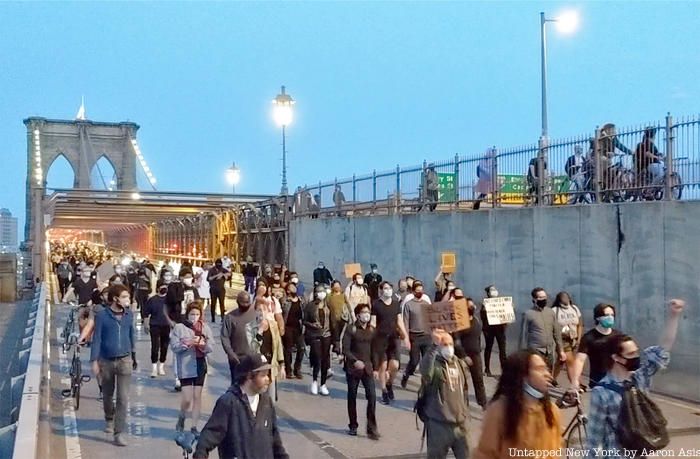
Demonstrators on Brooklyn Bridge, June 1st, 2020.
Stampedes don’t only take place in immense gatherings, like the annual hajj in Mecca. An excellent account of how crowds can quickly turn into stampedes can be found in an article in Vanity Fair by William Langwiesche, “The 10 Minute Mecca Stampede That Made History”, which goes over the 2015 stampede in Mecca where approximately 2,400 people were killed, as well as how stampedes can easily occur in concert venues, nightclubs, sporting events, and large processions.
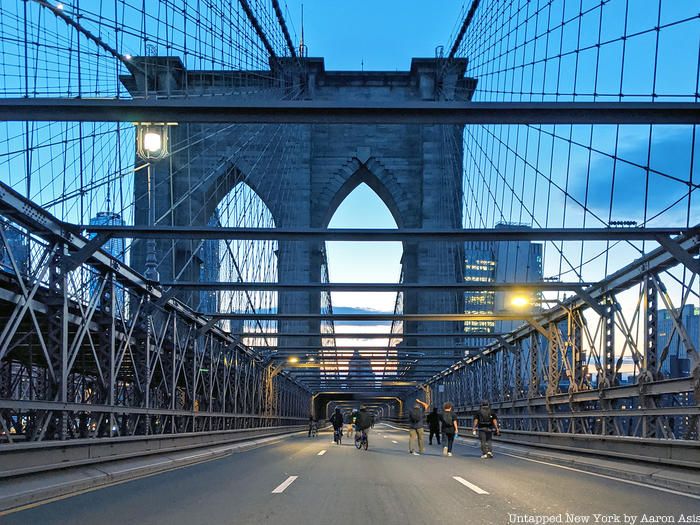
Brooklyn Bridge on June 1st, 2020 prior to the George Floyd demonstrations
Just six days after the Brooklyn Bridge opened to the public, a rumor quickly spread that the new bridge was about to collapse. The resulting panic caused such a massive stampede that twelve people were killed in the crush. The tragic incident started the afternoon of May 30, 1883 when a woman tripped and fell descending the wooden stairs on the Manhattan side of the bridge. Apparently, this caused another woman to scream at the top of her lungs, which caused those nearby to rush towards the scene. The commotion sparked a chain reaction of confusion, as more and more people panicked and mobbed the narrow staircase, creating a massive pileup. Thousands were on the promenade, quickly turning the situation deadly.
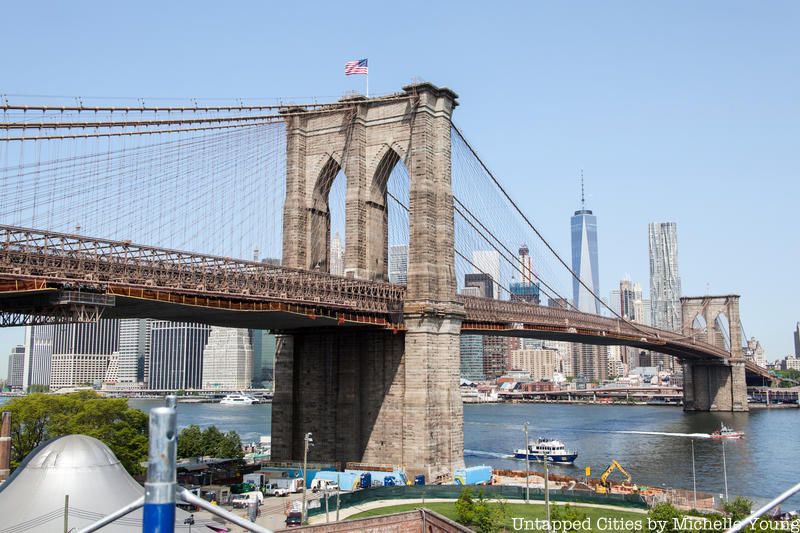
At the time, the bridge was the only land connection between New York and Brooklyn, which were then two separate cities. Opening day, the mayors of each city met in the center and locked arms as part of a spectacular celebration. Special trains had brought thousands from Long Island and Philadelphia to see the novel bridge. In the following days, masses of New Yorkers, Brooklynites, and visitors alike flocked to walk across the “New York and Brooklyn Bridge.” In the first day alone, 150,300 people made the crossing.
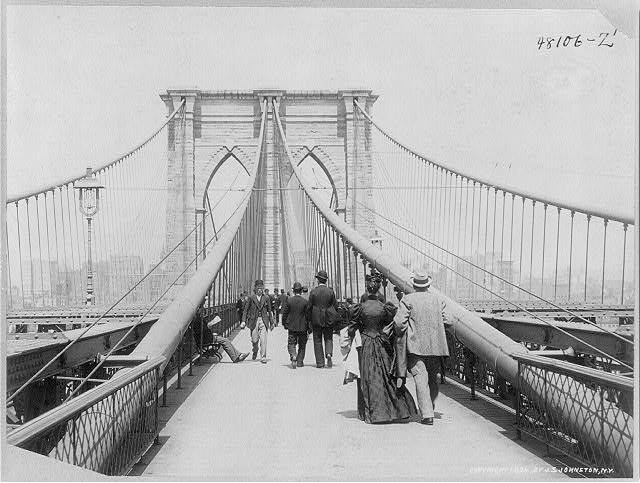
Brooklyn Bridge circa 1894. Photo from Library of Congress.
The tragedy highlights the doubt in that era that a bridge could be built big enough to span the East River. With a span of 1,595 feet 6 inches, at the time it was by far the longest bridge in the world, and 50% longer than any suspension bridge ever attempted. The two stone 276-feet-tall towers were the tallest structures in New York, except for Trinity Church‘s spire. Twenty-seven workers had died during 14 dangerous years of construction, as well as John Roebling, the designer of the bridge. In the previous decades, dozens of failed suspension and iron bridges had collapsed around Europe and the US, killing hundreds. Since this was the first suspension bridge to use steel cables, it was new, unproven technology.
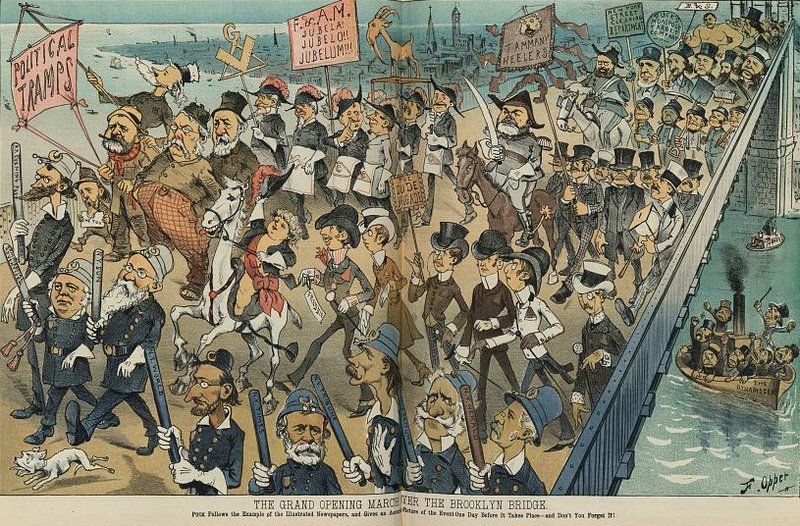 Grand Opening March over the Brooklyn Bridge. Frederick Burr Opper, artist, from the Illustrations from Puck. Image from Library of Congress.
Grand Opening March over the Brooklyn Bridge. Frederick Burr Opper, artist, from the Illustrations from Puck. Image from Library of Congress.
So when a panic broke out on the Brooklyn Bridge in 1883, you can imagine how many were already a little nervous about being suspended 135 feet above the water. Believing a collapse was imminent, terrified pedestrians scrambled for the exit, trampling one another. Panicked men, women and children piled on top of each another and became trapped against the iron fences that line the narrow promenade. In true old-time New York fashion, pickpockets came to rob the helpless victims.
Eventually, some quick-thinking workers were able to cut away some of the iron fence, allowing trapped victims to escape from the promenade onto the streetcar tracks below, which are now the two center traffic lanes. Afterwards, The New York Times described a vivid, gruesome scene, littered with gloves, shawls, handkerchiefs, smashed jewelry, crumpled men’s and women’s hats, and shredded trimming from ladies’ dresses. Broken canes and torn parasols spattered with blood were strewn about the roadway. 12 had died on the stairs, and more than 35 were wounded.
The following year, P.T. Barnum helped to reassure the pubic of the bridge’s safety (while publicizing his circus) by leading a parade of 21 elephants over the bridge. The stunt is memorialized in the children’s book, 21 Elephants and Still Standing. Anyone who was comforted by this demonstration really shouldn’t have been, since the bridge was overbuilt to be six times stronger than necessary, with a capacity of 18,700 tons, or over 2,500 African elephants. In 2017, a monument to the “Brooklyn Bridge Elephant Stampede” popped up in Brooklyn Bridge Park.
Want to learn more crazy stories from the history of the Brooklyn Bridge? Join Untapped New York for a Secrets of the Brooklyn Bridge walking tour!
This article written by Alex Wallach and Michelle Young.
Subscribe to our newsletter